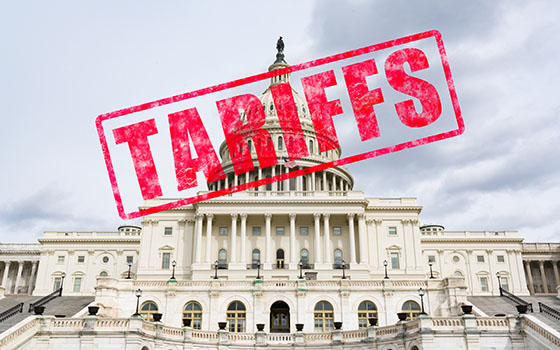All U.S. West Coast Ports will bear the brunt of tariffs
More than one official predicted declining January imports as new U.S.-imposed tariffs take effect. Others said import volume should keep climbing until then.

A potential U.S.-China tit-for-tat over tariffs hasn’t dampened cargo volume growth at California’s third largest ocean cargo gateway so far. In fact, the Port of Oakland is on track for its third straight year of record container volume in 2018.
But for Pacific Rim logistics managers, the one looming question is “can it last?” When Oakland convened its quarterly meeting of its “Efficiency Task Force” last month, the jury certainly appeared to be out on this one.
Since its creation three years ago, the Task Force still comprises stakeholders drawn from a variety of trade sectors, including longshore and labor representatives, freight intermediaries, and executives from the nation’s leading ocean cargo shippers.
In their recent evaluation of trade dynamics the majority of these members maintain that cargo volume is spiking right now but could drop by January.
Here were the trends noted by Task Force members assembled in Oakland:
- Warehouses are filling up as U.S. retailers import merchandise from Asia.
- Shipping lines have added more than 30 extra voyages to regularly scheduled Transpacific services to transport larger container volumes.
- Ports up and down the West Coast have reported unprecedented cargo volume growth since mid-summer.
Reasons for the cargo spike vary, according to industry analysts. It could be the result of a continued strong U.S. economy, who note that this is also was the peak season when importers ordered heavily for holiday merchandising.
Finally, a third explanation was top of mind for Oakland’s Efficiency Task Force – frontloading. Experts said that shippers have accelerated orders to beat the imposition of new tariffs on Chinese imports.
“Imports are a good story, but the reason for the growth is still something of a mystery,” says Port of Oakland Maritime Director John Driscoll. “We suspect frontloading is part of the answer.”
More than one official predicted declining January imports as new U.S.-imposed tariffs take effect. Others said import volume should keep climbing until then.
Oakland said its import volume is up 2.7 percent over 2017 which was a record year for containerized cargo at the port. Furthermore, imports from China have increased 5 percent this year, despite the tariff skirmish.
Oakland exports to China have declined 33 percent in 2018, with spokesmen attributing that trend to be consequence of tough new Chinese restrictions on wastepaper shipments – an Oakland export staple.
“As Oakland's China exports decline, other Asian nations are picking up the slack,” observes Mike Zampa, the port’s communications director. “Export shipments to Vietnam soared 96 percent in September, for example, and exports to Taiwan increased 37 percent.”
But smaller U.S. West Coast ports may have a tougher time of mitigating the impact of a prolonged trade war with China, say analysts from Beacon Economics, a prominent California think tank.
Jock O’Connell, Beacon Economics’ International Trade Advisor, notes that the Port of Stockton in the San Joaquin Delta in northern California has reported job and revenue losses as the result of a slowdown in shipments of 150-meter segments of rail that the Union Pacific Railroad imports from Japan.
“Manufactured by the Sumitomo Corporation, the rail segments are shipped to Stockton aboard a specially designed vessel, the Pacific Spike,” he says. “The segments are then welded at the Port of Stockton into 450-meter segments that Union Pacific uses in upgrading trackage along its 32,000-mile network in 23 states.”
Up in the Pacific Northwest, China’s retaliatory tariff on U.S. soybeans will hit ports like Kalama, Longview, and Vancouver (Washington) hard during a shipping season that normally starts in August or September, peaks in October and November, and then tails off into early the next spring.
“Larger ports handling a more diverse array of goods are better able to withstand the blow of higher tariffs,” concludes O’Connell, but that’s not much of a consolation for mega-port director Executive Director of Long Beach.
He notes that the evolving effects of the U.S.-China trade war is becoming apparent.
“Our higher import volumes suggest some retailers expect U.S. consumers will be big spenders this holiday season,” he says. “Other importers are rushing shipments to beat escalating tariffs. At the same time, the trade war has clearly slowed American exports to China.”

Article Topics
Ports News & Resources
U.S.-bound import growth track remains promising, notes Port Tracker report Q&A: Port of Oakland Maritime Director Bryan Brandes Signs of progress are being made towards moving cargo in and out of Baltimore New Breakthrough ‘State of Transportation’ report cites various challenges for shippers and carriers in 2024 Industry experts examine the impact of Baltimore bridge collapse on supply chains Port of Baltimore closed indefinitely to ships after 1.6-mile Key Bridge collapses following maritime accident February and year-to-date U.S. import growth is solid, reports S&P Global Market Intelligence More PortsLatest in Logistics
Investor expectations continue to influence supply chain decision-making The Next Big Steps in Supply Chain Digitalization Warehouse/DC Automation & Technology: Time to gain a competitive advantage The Ultimate WMS Checklist: Find the Perfect Fit Under-21 driver pilot program a bust with fleets as FMCSA seeks changes Diesel back over $4 a gallon; Mideast tensions, other worries cited Four U.S. railroads file challenges against FRA’s two-person crew mandate, says report More LogisticsAbout the Author
Subscribe to Logistics Management Magazine

Find out what the world's most innovative companies are doing to improve productivity in their plants and distribution centers.
Start your FREE subscription today.
April 2023 Logistics Management

Latest Resources














